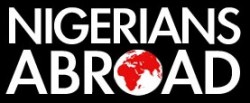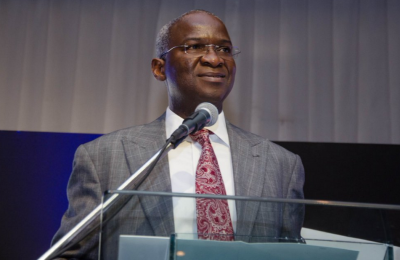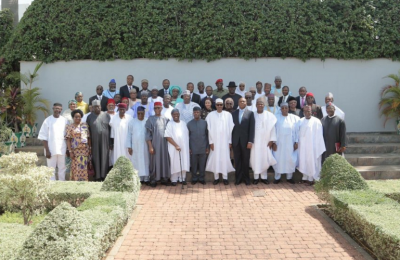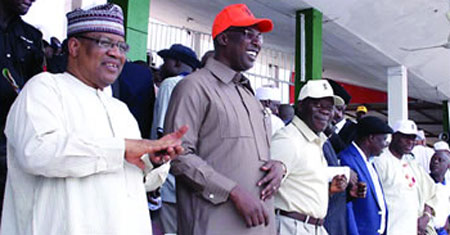By Giles Omezi ; Executive Director, Bukka Educational & Research Trust
The Urban Age and Cities Programme of the London School of Economics invited Governor Fashola to deliver a lecture on Nigeria’s largest city. For Lagos watchers like Bukka, this marked an interesting point in recent global perceptions of the city. Placed within the context of the broadcast of the three part documentary series ‘Welcome to Lagos by the BBC earlier this year and a more bizarre documentary by Louis Theroux’s ‘Law and Disorder in Lagos’, there seemed to be a louder voice from without which appeared to dictate the tone and set the agenda for global perceptions of the city.
This it seemed sat in contrast to a frustratingly loud silence internationally from the State Government. Therefore, the Governors appearance at the lectern at the LSE provided the opportunity for the gaps to be filled, for the perhaps the ‘other side of the story’ to be told, I think however, that his appearance pointed to an inevitable reality; that Lagos has to break out of the national and regional cocoon it seems to locked in and establish its aspirations as a serious emerging international urban destination. More importantly the Governors detailing of his administration’s recent efforts at regenerating the city couched in the rhetoric of the ‘Lagos Megacity’ deserved further articulation for an international audience that included the architects Lord Rogers, David Adjaye, other international urban practitioners and thinkers as well as interested Nigerians.
The presentation was introduced by Professor Ricky Burdett, Director of LSE’s Urban Age and Cities programmes. He began by tracing the population growth from its 1952 size of 325,000 to its current disputed population of 10million[1] [2007 Federal Government of Nigeria census] to UN estimates of 15million in 2025,with an hourly growth rate of 40 persons [migration and births] in contrast to 43 persons in Mumbai and 1.4 persons in London. Professor Burdett stressed relevance of the city’s hyper growth and pointed to other challenges best summarised by the UNDPs Human Development Index[2] a measurement of three dimensions of Wealth, Health and Living Standards which currently allocates a figure of 1.2 to Lagos compared 100 in London. This number he continued, though low in comparison to London is over double the figure allocated for Nigeria, thus conforming to a global pattern which illustrates in his opinion, the abilities of cities to improve on the general wellbeing of citizens, a pattern which he felt needed a better understanding. Noting the positive achievements of the Governors administration in publicly funded healthcare initiatives and transport infrastructure improvement, Professor Burdett raised questions for the Governor to answer, around the ability of urban administrators to effect positive change for citizens through transformation in the short tenures of government without in his own term ‘destroying the DNA of the city, the quality of the city’, citing the current urban practice in London which he stated is concerned with transformation of parts of the city for instance the East End without ‘destroying that fine fabric and that economic and social balance’. He then welcomed the Governor to start his presentation.
Governor Fashola started his presentation with subtle defiance, obtusely referring to the Welcome to Lagos documentary and alluding to the more negative social and economic extremities that were highlighted as being universal to most cities globally and not unique to Lagos. He asserted very clearly the unique position of Lagos as an African City by opining: ‘I do not think that Lagos will be a European city; it will never be; because Europeans do not live there! But Lagos will ultimately be a city where life is sustainable, where the expectations of those who live there, and where those who come to do business there can be realised in a safe and orderly manner, where everybody irrespective of your status will find a place. That is the city we dream of.’
This set the tone for his presentation on the activities of the city’s current administration in tackling the extreme decline the city had undergone through the underinvestment over the decades of economic structural adjustment over the 1980s and 90s across the core sectors of transport, public health, security, employment and the environment. The rapid urbanisation of the city and the consequent growth of the grey economy, a few of the challenges which his administration is facing, he stated have converged to create an urban crisis which the government is addressing. Governor Fashola raised transportation as the major problem in Lagos but contrasted this with London which in spite of its developed and mature urban mobility infrastructure still suffers from traffic congestion. He hinted at the decentralisation of the Lagos from a monocentric to polycentric city based on 8 ‘new mini cities’ that might serve to break the ‘unidirectional’ traffic flows between the outlying districts of the mainland into the employment centres on the island parts of Lagos. Interestingly this axiality of large volume expressways are a consequence of the post independence urban planning of the city around the L shaped road systems that stream traffic through the 3 bridge bottlenecks which connect the mainland and the island. In fact, the Otto Koenigsberger led UN Technical Assistance Team proposed a road system that would shape the city into an ‘L-shaped metropolis with Lagos Island in the centre at the bend on the south-west corner’[3], this configuration was suggested in 1964 when the population of the Lagos Metropolitan Area according to ‘preliminary figures’[4] from the 1962 census was estimated at 726,600 at an average annual growth rate of 14% from the 1952 census estimates. Currently the population is estimated to have grown over 20 times to the present upper end figure of 17 million. The configuration of this expressway system was planned against a backdrop which sought to utilise the population growth trend of the previous decade as a basis, stating that ‘It would be unwise to plan for anything less than the continuation of the average growth rate of the past ten years’[5].
The Governor detailed his transport strategy which hinges on delivering improved urban mobility and infrastructure around an inter-modal system, citing a number of initiatives and projects; a new Bus Rapid Transport system [BRT] launched in 2008, 165 km of rehabilitated roads, expansion of the eastern and western corridor expressways, clearing congested bottlenecks like Oshodi and the advanced planning of 7 new light rail routes of which the construction of 2 lines running north – south [Red Line] and westwards [Blue line] have commenced. He illustrated the impact of these initiatives using a series of comparative ‘before and after’ slides stressing the importance of the Oshodi clearances on the easing of a major urban transport bottleneck that in his words have contributed positively to productivity. The Oshodi cloverleaf system with the seemingly stagnant sea of ubiquitous ‘Danfos’ and ‘Molues’ buses and dense ‘marketspace’ famously catalogued by Edgar Cleijnes late 1990s photographs for Rem Koolhaas led Harvard Project on the City publication Mutations has been cleared. The informal mass transit system of yellow Danfo and Molue buses absorbed through innovative ownership schemes into the BRT system, a sort of communal Private Public Participation that one suspects is structured to bring the influential transport unions onside. Interestingly, the slide the used to illustrate this orderly transition was aptly titled: ‘ Optimal Utility of Existing Assets’.
One major achievement the Governor highlighted was the growth in ‘Internally Generated Revenue’ or put simply: taxes. Lagos State has improved its tax revenue collection system over the past 6 years, witnessing a growth from NGN 600 million per month to close to NGN 14 billion currently through a private sector led initiative; the state has outsourced tax revenue collection to a private firm with resulting impressive results and the state understandably wants more. He announced a new compulsory registration system to enable the state ‘plan’; a means of cataloguing the urban citizenry and of course placing a tax liability entry to each name. Another major visible initiative is one of infrastructure renewal, old roads rehabilitated with the consequent re-emergence of main commercial centres of say Surulere on the west central mainland.
The Governor also mentioned his administrations work in primary healthcare involved tackling the infant and maternal mortality by providing 800 maternal child care centre beds double the previous statewide figure of 400 public funded beds over a period of 3 years. For a 17 million population city, this no doubt represents a huge deficit to bridge and a sense of the magnitude of challenges facing the administration of the state. Supply of potable water has been increased from 55 million gallons per day to 155 million gallons per day with a supply target of 769 million gallons per day to be achieved through private sector participation. He listed the improvement in security as a major achievement, citing cooperation with the private sector through pooled funding in a Support & Trust Fund that is channelled towards equipment, logistic support and welfare for the police force in the state which he stated has led to 79.9% reduction in crime across the state, declaring that subsequently; ‘Lagos is the safest state in the whole country and many parts of the sub region of West Africa’ this he stressed has resulted in an increasing night-time economy. This improved sense of security he mentioned now exists in contrast to a terrified city which three years ago shut its doors at 7pm in a heightened sense of insecurity, he speculated on a further improvement on security once an increase in electrical power generation becomes effective, bringing with it he hoped, an intensification of employment opportunities over a longer and more secure working day.
One visible area of intervention by the state has been in the public realm of the city, with a substantial ‘beautification programme’ of green landscaping of slack spaces of expressway medians and cloverleafs, the establishment of parks and gardens increasing in the Governors words the ‘green footprint of the state’ with a million trees planted and 880,803 sq metres of parks created in 3 years, acknowledging the benefit of an improved public realm to the perception of lifestyle quality of the city dweller. Closing his presentation, the Governor referred to the current challenges in Lagos as being ‘symptoms of unimplemented or failed plans’ the economic attraction of the city and continued inward migration acknowledged that proliferation of ‘unplanned settlements’ with ‘vulnerable residents’ whom the administration has resolved not to abandon. He listed the initiatives funded by World Bank and State programmes under the Lagos Metropolitan Development & Governance Project [LMDGP] which centre around; resettlement of communities where possible [Oko-Baba close to Makoko north west of the Lagos Lagoon was cited], integration of thirty identified ‘blighted’[6] areas into eight new town areas designated as ‘Model City Plans’, new housing plans and designs to prevent social stratification and new market and stall designs. He mentioned an egalitarian aspiration to co-locate diverse income groups to promote and encourage an aspirational but inclusive society both in residential and commercial developments. His administration has recently introduced new Town Planning and Urban Development Legislation, addressed delays in the judicial process for development control enforcement by devolving power to magistrates courts to deal with cases and increasing capacity within this tier of the state judiciary through the provision of additional courtrooms, training of Magistrates and weekend court sittings.
The Governor briefly mentioned the large developments along the eastern corridor of the Lekki, including; Eko Atlantic City, a new town with a projected population of 250,000 located on reclaimed land on the eastern seaboard of Lagos, and the 16,000 hectare Lekki Free Trade Zone further along the corridor. He defended during questions the privately funded toll road that feeds this corridor as necessary to ensure orderly development of the eastern Lekki corridor in contrast to the precedent of the western corridor where a proliferation of unplanned developments dominate. He further articulated the road rehabilitation programme of the state when questioned on the perceived omission of certain parts of north Lagos from the process, as being a carefully considered sequence that prioritises a gradual restoration of connectivity to the road network that was also enhanced through dialogue with local estate associations whom had set up secure gated enclaves that prevented traffic permeability through the city.
On the whole, the Governors presentation was comprehensive and demonstrated the substantial challenges faced by his administration, particularly the urgency in the sense of crisis that pervades the city and the determination correct this and also to restore a sense of normalcy to the city.
However Lagos and its administration have the unenviable task of grappling with its hyper population growth, social service delivery expectations of the populace and most importantly funding the aspirations to reconfigure the city to match the rhetoric of the Lagos Mega City aspirations. In seeking a series of collaborative models with private sector actors, both individual and corporate, the state appears to be opening up possibilities that seem more tuned to the African traditional sensibilities of dialogue and communal cooperation which somehow underscore Governor Fashola’s assertion on the city’s modernity one which in my opinion must seek institutional and structural constitution from within the essence of its own particularities. There is also a lingering sense of caution over the reliance on the corporate actors for private sector investment and the danger of not tackling the sharp socio-economic divisions that are reflected spatially in the city.
Giles Omezi writes for archiafrica.org














